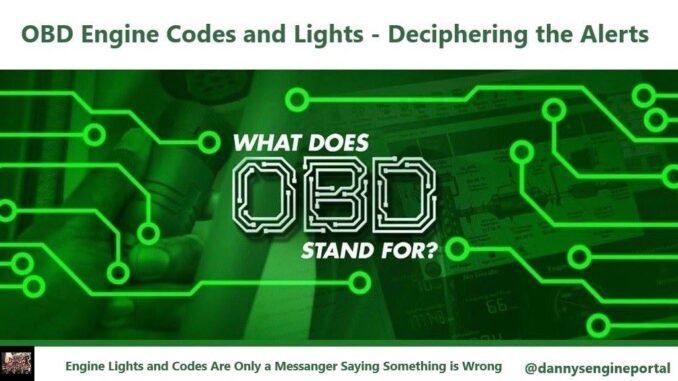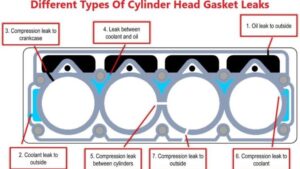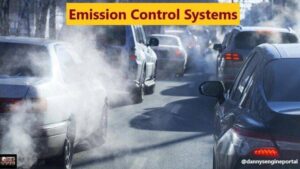
So, OBD engine codes and (CEL) lights, cannot be fixed by simply resetting them or disconnecting the battery.
And, eventually the OBD engine codes and (CEL) lights will come back. But, stay cool, the codes and lights are only a messenger.
In short, when this system identifies an issue it turns on a check engine light (CEL), and records (OBD) engine codes.
So, OBD engine codes and (CEL) lights, are the language your vehicle uses to communicate with you.
And, let you know that your vehicle, isn’t operating at top efficiency. So, most people think that the check engine light (CEL), is only there for the vehicle’s emission system.
However, this light informs the operator when there is something wrong, anywhere in the vehicles electronic engine control system.
The OBD System Includes:
- Sensors
- Solenoids
- Valves
- Actuators
- Lights
So, your vehicle needs these and many more, to operate properly. And, to troubleshoot, repair and maintain your vehicle you’ll need diagnostic repair information, that is specific to your vehicle.
First, there was (OBD)-I, first generation diagnostic codes. Now, we have (OBD)-II, second generation diagnostic codes.
(OBD)-II goes beyond emissions diagnostics and covers a wide range of vehicle components. Including the engine, transmission, brakes, and fuel system.
So, with only a few basic tools, a little patience and some mechanical know how. Most often, you can find and repair most of these concerns yourself.
So, How Do You Read These OBD Codes
The First Character Identifies The System Related To The Trouble Code:
- P = Powertrain
- B = Body
- C = Chassis
- U = Undefined
The Second Digit Identifies, Whether The Code Is A Generic Code Or A Manufacturer Specific Code:
- 0 = (Standardized Code ISO/SAE) Generic (this is the digit zero – not the letter “O”)
- 1 = (manufacturer specific OBD engine codes)
And, The Third Digit Denotes, The Type Of Sub System That Pertains To The Engine Code:
- 1 = Emission Management (Fuel or Air)
- 2 = Injector Circuit (Fuel or Air)
- 3 = Ignition or Misfire
- 4 = Emission Control
- 5 = Vehicle Speed & Idle Control
- 6 = Computer & Output Circuit
- 7 = Transmission
- 8 = Transmission
- 9 = SAE Reserved
- 0 = SAE Reserved
Codes – 4th and 5th, these digits are variable and relate to a specific problem.
Code Categories, What Do They Mean
P0100 – P0199 – Fuel and Air Metering.
So, here is a break down of some of the OBD engine codes:
- P0100 – P0104: Focus on the (MAF) or Volume Air Flow “A” Circuit. And, indicate problems with the sensor itself, its wiring, or its connection.
- P0105 – P0109: Relate to the Manifold Absolute Pressure/Barometric Pressure Circuit. And, suggest issues with the sensor responsible for measuring pressure, in the intake manifold.
- P0110 – P0114: Concern the Intake Air Temperature Sensor 1 Circuit. Signal potential problems with the sensor that measures the temperature of the air entering the engine.
- P0115 – P0119: These codes focus on the (ECT) Sensor 1 Circuit. And, will show issues with the sensor that monitors the temperature of the engine coolant.
- P0120 – P0124: These codes are related to the (TPS) Sensor/Switch A Circuit.
- P0125 – P0129: These codes are related to Coolant Temperature not Reaching Target Temperature.
- P0130 – P0167: These codes are related to (O2) Sensors and Associated Circuits.
- P0170 – P0175: These codes are related to Fuel Trim issues. And, indicate problems with the engine’s ability to maintain the correct air fuel mixture.
- P0180 – P0189: These codes relate to Fuel Temperature Sensor issues.
- P0190 – P0199: These codes are associated with Fuel Rail Pressure Sensor issues.
P0200 – P0299 – Fuel and Air Metering. (Injector Circuit)
So, here is a break down of some of the OBD engine codes:
- P0200 – P0209: These are Fuel Injector Circuit Malfunctions.
These codes point to issues within the electrical circuits controlling the fuel injectors. - P0200: This code signifies a general injector circuit malfunction. While, codes like P0201, P0202, etc., specify a problem with a particular cylinder’s injector.
So, possible causes include faulty injectors, wiring issues, or problems with the fuel injector driver circuits in the (PCM).
Symptoms may include engine misfires, rough idling, and decreased engine performance. - P0299: Turbocharger/Supercharger “A” Underboost Condition.
This code indicates that the turbocharger or supercharger is not producing the expected amount of boost pressure.
So, it’s a common issue in turbocharged vehicles. And, the P0299 code can trigger the (CEL) and potentially activate “limp mode”. - P0299: Include a faulty turbocharger. (e.g., sticking vanes or wastegate issues) Also, boost leaks, problems with the wastegate actuator or its control solenoid. And, issues with the boost pressure sensor or its wiring.
Symptoms include a loss of power, especially during acceleration. And, a noticeable lack of boost when the engine is under load.
P0300 – P0399 – Ignition System or Misfire.
So, here is a break down of some of the OBD engine codes:
- P0300: Random/Multiple Cylinder Misfire Detected.
This code suggests that the (ECU) has detected misfires that are not isolated to a single cylinder. And, often appears alongside other P030X codes, which specify the affected cylinder.
Causes can include faulty spark plugs, ignition coils, fuel injectors, vacuum leaks, or even internal engine issues. - P0301 – P0308: (and beyond) These codes indicate misfires in specific cylinders. (e.g., P0301 is cylinder 1, P0302 is cylinder 2, etc.) So, the underlying causes are similar to P0300, but are specific to the faulty cylinder.
P0400 – P0499 – Auxiliary Emissions Controls.
So, here is a break down of some of the OBD engine codes:
(EGR) System Issues: (P0400 – P0403)
- P0400: (EGR) Flow Malfunction.
This code signifies that the (EGR) valve is not flowing the expected amount of exhaust gas into the intake manifold. - P0401: (EGR) Flow Insufficient Detected.
The (ECM) detects that the (EGR) system is not delivering enough recirculated exhaust gases. - P0402: (EGR) Flow Excessive Detected. The (ECM) detects that the (EGR) system is flowing too much exhaust gas. (EGR) Circuit Malfunction. This code indicates a problem with the electrical circuit related to the (EGR) valve. Such as, a short or open circuit.
(EVAP) System Issues: (P0440 – P0499)
- P0440: (EVAP) Control System. This is a general code indicating a problem with the (EVAP) system.
- P0442: (EVEP) Control System Leak Detected. (small leak) This code indicates a small leak in the (EVAP) system.
- P0446: (EVAP) Control System Vent Control Circuit. This code relates to a fault in the vent control circuit of the (EVAP) system.
- P0455: (EVEP) Control System Leak Detected. (gross leak) This code indicates a large leak in the (EVAP) system.
- P0499: (EVEP) System Vent Valve Control Circuit High. And, signifies a high voltage in the vent valve control circuit of the (EVAP) system.
P0500 – P0599 – Vehicle Speed Controls (VSS) and Idle Control System.
So, here is a break down of some of the OBD engine codes:
- P0500: (VSS) Sensor “A” Malfunction. This is a general code indicating a problem with the (VSS) or its circuit.
- P0501: (VSS) Sensor “A” Range/Performance. This code means the (VSS) is providing an erratic or out-of-range signal.
- P0502: (VSS) Sensor “A” Circuit Low Input. And, it indicates a low voltage signal from the (VSS).
- P0503: (VSS) Sensor “A” Intermittent/Erratic/High. It suggests the (VSS) signal is inconsistent or excessively high.
Other Codes in the Range:
- P0504: Brake Switch “A”/”B” Correlation. This code relates to the brake light switch and its interaction with other systems.
- P0505: Idle Control System Malfunction. It indicates a problem with the system that controls engine idle speed.
- P0599: Thermostat Heater Control Circuit High. This code signals an issue with the thermostats heater circuit.
P0600 – P0699 – Computer Output Circuit.
So, here is a break down of some of the OBD engine codes:
P0700 – P0999 – Transmission.
So, here is a break down of some of the OBD engine codes:
- P0700 – P0709: These codes often signal a general malfunction within the transmission control system. Common causes include faulty (TCM)s, wiring problems, or issues within the transmission itself. Specific codes like P0705 (Transmission Range Sensor circuit) or P0703 (Brake Switch “B” Circuit) point to specific components.
- P0710 – P0799: These codes cover a wider range of transmission related issues. Including, problems with sensors (input/output speed sensors, temperature sensors), solenoids (shift solenoids, pressure control solenoids), and other control system components.
- P0900 – P0999: These codes specifically address the clutch actuator circuit. Also, the clutch position sensor in vehicles with automatic transmissions that feature clutch control systems.
Lets the driver know that there is a fault, in the transmission computer. And, the (TCU) needs to be scanned for OBD engine codes.
So, now you have a better idea of what makes up, a Diagnostic Trouble Code (DTC). And, you can see that every digit has its purpose. As a result, you know which system is having the problem, just by knowing what the first few digits are.
In Summary: OBD Engine Codes
So, OBD engine codes, are accessed by using a code reader, that you insert into the vehicle’s (OBD) port. Consequently, these codes provide you with, the information about the system. And, what the conditions were, when the issue was first detected.
However, they can’t provide a clear cut solution, to the actual cause of the problem. Because (CEL) lights, are only a messenger that tells you something is wrong.
Thank You !!





